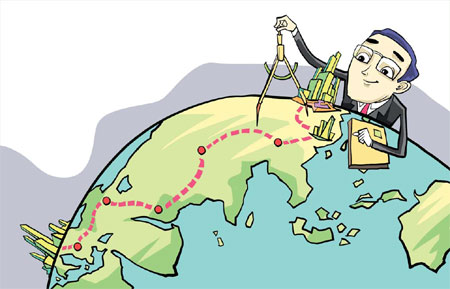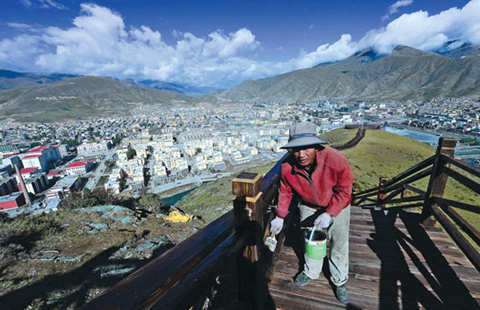The once and future route to riches
Updated: 2014-08-29 09:23
By Giles Chance(China Daily Europe)
|
|||||||||||


China's role in developing the new Silk Road again shows how it is bringing change to its trading partners
US President Barack Obama's east Asian visit in April 2014 to Japan and other countries around the South and East China seas diverted global attention from a major geopolitical event taking place on the other side of China: the emergence of China-led economic, security and diplomatic cooperation in Central Asia, focused on the countries on and near the historic Silk Road.
This development carries real potential to change the global balance of economic and geopolitical power.
The ancient trading relationships between China and its western neighbors provide a solid foundation for the creation of a Central Asia bloc, with China at its head and involving the other major power in the region, Russia, which could enhance regional security and economic development.
In a part of the world where Muslim extremism and nationalist unrest create potential for global instability, China's interest in the new Silk Road should be welcomed by a Western world that lacks the long-embedded local relationships and understanding to bring lasting peace to Central Asia.
Recent speeches by President Xi Jinping have emphasized the potential for China-led economic development of the region.
If you include Iran (but not Russia or Iraq), the region west of Xinjiang contains over 160 million people, but its GDP is only $60 billion in purchasing-power terms - smaller than most Chinese provinces.
The potential for growth is obvious. A new dynamic economic hub based in western China, stretching westward to the Caspian Sea and beyond would be a game-changer both for China and for all the countries throughout Asia, from the east to the west. India would also become a major beneficiary.
Economic development would bring prosperity and stability once again to a region associated with poverty and decline since the Silk Road's importance diminished about 500 years ago, as the seaborne East-West trade route became more attractive.
Many people already know how China became linked with the Mediterranean Sea and Europe through the 6,500-kilometer cross-country trading route stretching across Central Asia called the Silk Road.
Tourists have marveled at the riches created by the Silk Road's trade, to be seen in the artistic and architectural culture of cities like Venice, which gained enormous wealth by exploiting the Silk Road from the western end and in China.
East first clashed with West at Bukhara, now in Uzbekistan (and a UNESCO World Heritage site), when in 36 BC, a military expedition from China, traveling west, met and defeated a Roman army traveling east.
From China's western gate at Dunhuang, the arduous trading route passed around the Taklamakan Desert and over the Pamir Mountains, a northwest spur of the Himalayas, through Kyrgyzstan, Tajikistan, Uzbekistan, Turkmenistan, Iran, Iraq and Syria, before reaching Turkey and the Mediterranean.
Kashgar, Samarkand, Bukhara, Merv, Teheran and Aleppo are all cities with ancient and romantic traditions of East-West trade stretching back thousands of years.
But fewer people are aware that a series of recent Chinese initiatives is bringing new life and vigor to these old trading posts.
Shortly after taking power in late 2012, President Xi Jinping and Premier Li Keqiang started a series of visits to countries lying to the west of China, including Turkmenistan, Kazakhstan, Uzbekistan and Kyrgyzstan; all were countries lying along the eastern end of the old overland East-West trading route.
China's diplomatic initiative mirrors a similar interest taken 2,000 years earlier by the powerful Han emperor Wu Di, whose envoy Zhang Qian returned in 125 BC after 13 long years, during which he had traveled as far west as Bactria, in northern Afghanistan.
After his envoy returned, Emperor Wu Di sent expeditions westward to open up what is now Xinjiang.
Two decades later, in 106 BC, the first trade caravan carried Chinese goods directly, without transshipment, to modern-day Iran.
By 50 BC, a market was established in Rome to trade the silk brought from China. In his famous history of China written during Emperor Wu's reign, the great Chinese historian Sima Qian commented on the trading activities centered on the imperial city of Xi'an, and on the wide range of imports brought by traders into China from the west which included camphor wood, jade, horses and even beautiful women.
Today, the extension of China's influence along the old Silk Road still depends on the powerful pull of East-West trade. But it's not spices and gold that interest China. The countries around the Caspian Sea, including Iran and Kazakhstan, account for more than one-third of global reserves of natural gas, and over 10 percent of oil reserves.
Further exploration carried out by China's oil companies, acting in partnership with national and multinational energy organizations, will undoubtedly uncover much more in this region.
Much of China's energy already comes from gas and oil pipelines which link China's main cities with Iran and the Caspian Sea.
The contracts that are being signed and the investments being made now in Central Asia by China's energy companies will emphasize the country's vital reliance for energy on its western neighbors.
In return, China can offer development assistance, backed by its own successful experience since 1980 and by Chinese money in the form of concessionary loans denominated in Chinese yuan, not dollars.
China's projection of the yuan into the energy-rich central Asian region will strengthen its claims to be an important global currency.
The vulnerability of China's seaborne trade links, which narrow to a channel only 2 miles (2.8 kilometers) wide in the Strait of Malacca near Singapore, create another strong incentive for China to look to its overland trade links with the West.
Already the US computer and printer manufacturer Hewlett-Packard is shipping equipment made in Chinese factories by the three-week overland route from Chengdu to Germany, cutting the time taken by the East-West seaborne route in half.
In a few years, it will be possible to ship containers overland from a range of transport hubs in eastern and western China to destinations and ports throughout Europe, at a fraction of the price and with a fraction of the time taken by seaborne traffic.
Here, at last, is a major incentive to drive the economic development in western China long sought by the government in Beijing.
The impact of the new Silk Road on Xi'an and other major western Chinese cities, and eventually on all the cities and countries along and near to the new Silk Road, will be considerable and long-lasting.
The potential impact of the new Silk Road is not just economic. The Shanghai Cooperation Organization, formed by China and Russia in the mid-1990s to resolve central Asian border disputes, has brought important issues of diplomacy and security to this Central Asian dialogue, of increasing interest to countries on the periphery like Pakistan, Turkey and even Sri Lanka.
In the early and middle part of the 2000s, China's emergence created a resource boom that transformed the economic and social fortunes of many emerging countries in South America and Africa.
China's involvement in the new Silk Road will have an equally significant impact on many Central Asian countries that boast ancient and rich cultures, but also with economies and societies longing for development.
It is another example of China's growth and global emergence bringing beneficial change to its neighbors and trading partners, as well as to itself.
The author is a visiting professor at Guanghua School of Management, Peking University. The views do not necessarily reflect those of China Daily.
(China Daily European Weekly 08/29/2014 page12)
Today's Top News
Obama says 'no IS strategy yet'
China calls for ceasefire in Ukraine
British PM stresses advantages for Scotland to stay in Britain
Girl, 9, kills shooting range instructor
IMF chief Lagarde investigated in graft case
1,400 children exploited in UK town
China, Russia enhance military ties
Turkish FM elected as premier
Hot Topics
Lunar probe , China growth forecasts, Emission rules get tougher, China seen through 'colored lens', International board,
Editor's Picks

|

|

|

|

|

|





